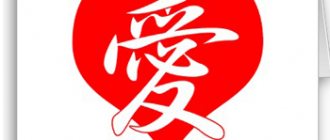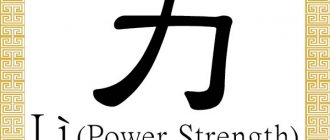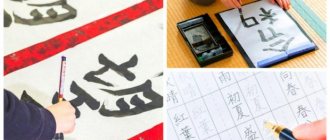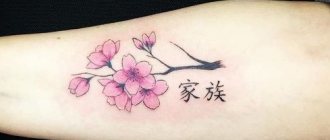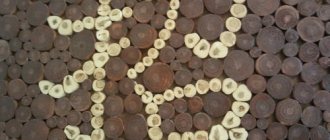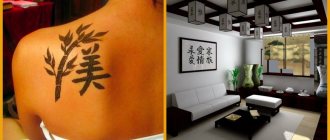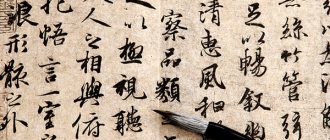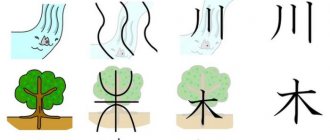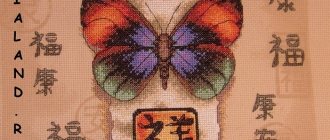Chinese writing is hieroglyphic. Hieroglyphs are also found in other languages influenced by China - Japanese and, to a lesser extent, Korean. The Vietnamese language used hieroglyphic writing until the 20th century. Students of these languages are especially faced with the question of how many hieroglyphs they need to know, how to remember them and, most importantly, not forget them.
Chen Zhisheng, calligraphy. China National Art Museum in Beijing
How many hieroglyphs are there in total?
The character in the classical written language Wenyan 文言 usually meant a whole word. In modern Chinese, words mostly consist of one or two, rarely three or more characters. Therefore, there are a lot of hieroglyphs.
In 1994, the dictionary “Sea of Chinese Characters” by Zhonghua Zihai 中華字海 was published, which contains 85,568 characters! True, the vast majority of them can be found only a few times in classical literary works. Conventional bilingual dictionaries contain about 6-8 thousand hieroglyphs, among which there are also many rare ones. More complete explanatory dictionaries contain about 10-20 thousand characters.
It is believed that to understand 80% of modern ordinary Chinese text , it is enough to know the 500 most common characters, knowledge of 1000 characters gives an understanding of approximately 91% of the text, and 2500 characters - 99% of the text. In order to pass the highest level Chinese language exam for foreigners, HSK 6, you need to know just under 3,000 characters. To read specialized scientific or classical literature, you need to understand a larger number of hieroglyphs.
However, you must keep in mind that even if all the hieroglyphs in the text are familiar to you, you will not always completely understand the meaning of what is written. You also need to know words—various word combinations of hieroglyphs. The Chinese language uses quite a lot of abbreviations, when stable phrases of several characters are reduced to shorter ones.
For example, the phrase “Beijing University” 北京大学 Běijīng dàxué is shortened to 北大 Běidà, which literally means “northern big”. Another difficulty in the Chinese language is the use of chengyu成语, an idiom typically consisting of four characters. If each sign is translated literally, the meaning of what is said may not be understood. There are special Chenyu dictionaries, as well as collections of stories that explain the meaning of the most famous idioms. Translations of chengyu can also be found in dictionaries.
♦ On topic: What is chengyu
In the Japanese language, there is a mandatory list of Joyo kanji characters 常用漢字, accepted by the Japanese Ministry of Education as sufficient for everyday use.
It consists of 2,136 kanji (hieroglyphs) and includes 1,006 kyoiku kanji, which are studied by students in 6-year elementary school and 1,130 kanji, which are taught in middle school.
Hieroglyph structure
At first glance, the hieroglyph seems to be a chaotic collection of various lines and dots. However, it is not. There are several basic elements that make up a hieroglyph. First of all, these are the features that make up graphemes. Graphemes, in turn, form a more complex sign.
♦ On the subject: Gateway to Calligraphy: Eight Principles of Writing the Character Yun 永
Traits
Any hieroglyph consists of a certain set of features. The traits themselves have no lexical meaning or reading. There are four types of traits and more than two dozen varieties:
- Simple (basic) features: horizontal, vertical, inclined left and right, folding left and right, special points.
- Features with a hook: horizontal, vertical (can be with a hook to the left or a hook to the right), folding to the right.
- Broken features: the line changes direction one or more times, has a complex configuration.
- Broken features with a hook.
There are also slightly different classifications of traits, but this does not change the general essence. The lines in hieroglyphs are written in a strictly defined sequence: “first horizontal, then vertical, first folding to the left, then folding to the right, first upper, then lower, first left, then right, first in the middle, then on both sides of it, first we go inside , then we close the door.”
In the past, hieroglyphs consisted of a large number of strokes, and remembering them was not easy. Therefore, one of the goals of the writing reform carried out by the Chinese government in the 60s of the 20th century was to simplify the characters by reducing the number of strokes.
A similar simplification of hieroglyphs was carried out in Japan. However, simplified Japanese characters do not always correspond to Chinese ones, although knowing the full and simplified versions of Chinese characters, it is usually easy to understand the simplified Japanese ones. For example, the word "library" written in Simplified Chinese: 图书馆, Long Chinese: 圖書館, and Japanese: 図書館. In Chinese it is read túshūguǎn, in Japanese - toshokan.
In Taiwan, Singapore and some other places, the full version of writing hieroglyphs is still used. And in mainland China you can find texts written in full hieroglyphs. In addition, hieroglyphs with several dozen features have survived to this day. As a rule, they are rarely used and therefore have not been simplified.
The most difficult character to write is considered to be biáng (byang), which consists of more than 60 strokes. It refers to a type of noodle popular in Shaanxi Province. Outside the region, this hieroglyph is practically not used, and therefore it is absent from dictionaries and computer fonts.
The hieroglyph "byan" is considered the most difficult to write. They say that students at one of the institutes in Chengdu were systematically late for classes. And the professor, angry with them, ordered everyone to write the hieroglyph “byan” a thousand times. Not everyone was able to do this. And everyone tearfully asked for forgiveness, promising not to be late for classes in the future.
Graphemes and clues
Graphemes are formed from traits - simple hieroglyphic signs with stable lexical meanings. These are the basic characters of Chinese hieroglyphic writing that make up Chinese characters. They are the most ancient and express the basic elements of the surrounding world and man.
Examples of graphemes: man 人 rén, woman 女 nǚ, child 子 zǐ, sun 日 rì, sky 天 tiān, earth (soil) 土 tǔ, etc.
♦ Read more about the history of Chinese writing and the PRC reform to simplify hieroglyphs in the article “Chinese characters from antiquity to the present day.”
There are about 300 graphemes in total; linguists differ in their estimates regarding their exact number. Most graphemes are used in modern Chinese writing as the most common characters. Graphemes make up about 10% of the most commonly used hieroglyphs.
In addition to graphemes, there are keys . Keys are the main classification marks. The standard list of keys contains 214 characters. It includes many graphemes and some features that do not have a fixed meaning. Thus, not all graphemes are keys and not all keys are graphemes.
For a long time, a list of 214 keys constituted the so-called hieroglyphic index, according to which hieroglyphs were ordered in Chinese dictionaries. However, after simplified hieroglyphic writing was introduced into the PRC, some characters underwent either partial simplification or structural changes.
For students of languages with hieroglyphic writing, knowledge of the key table is mandatory.
Complex signs
Most hieroglyphs consist of two or more graphemes. Traditionally, they are divided into two large groups: ideographic signs and phonideographic signs.
Ideographic signs
Ideographic signs (ideograms) consist of two or more graphemes. In them, the meaning of the hieroglyph is derived from the semantics of the graphemes included in it, but the reading of the hieroglyph is in no way connected with them. In modern Chinese, the share of ideographic signs is about 10%.
Examples of ideograms:
- 好 hǎo (good): 女 nǚ (woman) and 子 zǐ (child)
- 明 míng (understanding, enlightenment): 日 rì (sun) and 月 yuè (moon)
- 休 xiū (rest): 人 rén (person) and 木 mù (tree)
- 众 zhòng (crowd): three people 人 rén
- 森 sēn (forest, thicket, dense): three trees 木 mù
Phonoideographic signs
About 80% of hieroglyphs are so-called phonideographic signs, or phonideograms. Hieroglyphs of this type usually consist of two parts. One part is called the semantic factor , or hieroglyphic key . It indicates that the hieroglyph belongs to a certain group of semantically related characters and thereby suggests an approximate meaning.
The other part of the hieroglyph is called the phonetic and suggests an approximate reading. After the reform of Chinese writing, the number of phonideograms consisting of two graphemes increased significantly, which greatly facilitated the memorization of hieroglyphs.
Examples of phonoidograms:
- 妈 mā (mother): 女 nǚ (woman - key) and 马 mǎ (horse - phonetician)
- 性 xìng (nature, character, gender): 心 xīn (heart, consciousness - key) and 生 shēng (birth - phonetician)
- 河 hé (river): 水 shuǐ (water, in the hieroglyph “river” the element “water” in the left position changes to a flap with two dots - key) and 可 kě (modal verb of possibility or obligation - phonetic)
However, in the process of development, the reading of many hieroglyphs has changed and nowadays it is not always possible to guess even the approximate reading of a hieroglyph. Especially when it comes to dialects of the Chinese language.
List of the easiest
Each character in Chinese writing has its own meaning. It happens that a hieroglyph reflects the meaning it resembles. Some signs express their entire meaning with the help of a simple illustration.
But these are the simplest symbols, and their minimum number. There is no need to think that such signs need to be given less time when studying. After all, what required minimal effort may not work at some point. Next, we will look at the ten main characters of Chinese writing.
Yī
This symbol is depicted as a horizontal stick, which is the length of one letter. Such a simple symbol should mean something simple. That’s right, standing apart from the others, it means the number one. It is easy to remember by understanding the Chinese counting method - one stick means one, two sticks means two, and so on.
Knowing the meaning of symbols without understanding how they work in a sentence will not be enough. To explain in a simple way the method of constructing words, we can give an example: if after the sign “ten” you write “one” next to it, you get eleven. “Thirteen” is made in the same way.
Ren
A very common symbol. It resembles a child’s drawing of a hut, but in reality it means “Man”. To make it easier to remember, you can imagine that there is a head at the top, and the falling side lines are equipped with shoes.
It is written simply. First, one arc goes from above to the left, then from above it goes to the right.
If you use "one", "pointer" and "person" in sequence, you get the meaning "one person".
Rù
Very similar to the previous one in appearance, but very different in meaning. If you add a small line from the top to the left to the sign for “man,” the meaning changes to “enter.”
It is easier to remember by visualization. It looks like something sharp that penetrates the wood. It is written in exactly the same way as “man”, only the dash is indicated first, and then the side arcs.
Rì
It’s already harder to visualize, because before this hieroglyph was written differently. Once upon a time it was a circle with a dot in the middle. The meaning was easy to remember and obvious. The most important circle in a person’s life, what is it? That's right, solar, so the meaning of this symbol was “sun”, or the time of day when it was visible “day”. The modern look has been changed to a square with a small line. It is written simply:
- The first vertical line is on the left.
- The second horizontal top.
- Then vertical right.
- At the end, the middle and lower horizontal line is drawn.
Shan
Already a simpler symbol that looks like a trident. It also looks like three mountain peaks. Therefore its meaning is "mountain". Very easy to write and remember, it is written as follows:
- The vertical left and horizontal bottom lines form a shelf.
- The largest and the same as the first line are placed on it alternately.
Kǒu
Hieroglyph in the form of an empty square. When many people see it, they think that the computer’s drivers simply cannot show this sign. On the monitor it looks like a bug in the program code, but its creators never thought that such a problem would arise. It means “entrance”, “whale”, “list” or “mouth”. It is written on paper in the same way as the sun, only without a center line. The combination of "person" and "list" forms "population". The logic is difficult to understand, especially if you don’t know the background.
Zhōng
Creators are increasingly moving away from the idea of simplicity and intelligibility. Depending on the context, this symbol can have the meaning “and “middle”. In fact, if you imagine a three-dimensional model of this symbol, you can see a plane that is pierced by a vertical line in the middle. It looks like a horizontal rectangle, the center of which is crossed by a straight line.
Hǔo
Well, here you don’t have to use much imagination to see “fire” in this Chinese character. At first it may seem that this is a “person” waving the arms that appear, but no. It is written on paper in the same way as “man”, but first you need to designate the flames that envelop it from all sides. If you write “fire” and “mountain” in sequence, you get “volcano”.
Nǚ
A difficult Chinese character to write. It means "woman". But to imagine it you need to strain. He wondered how the lady bowed her head slightly. First you need to write the top line and the left leg, then the right leg crossing it. To indicate that we are talking about a human woman, you need to add the symbol “human”.
Men
The symbol looks like a door in an old cowboy saloon. The Chinese also thought so and decided to mark the door for them. It is written as follows:
- Long vertical lines first.
- Then 6 short horizontal ones.
- And then two vertical ones.
Easy ways to remember writing hieroglyphs
I think you are convinced that the hieroglyph has a clear structure and cannot contain random elements. This makes it quite easy to remember the spelling and meaning of hieroglyphs.
Graphemes go back to pictograms, representing modified, extremely simplified and abstract drawings. On the Internet you can find many pictures showing how the image gradually became more abstract and abstract. This helps with quick memorization.
The most ancient hieroglyphs, from which modern ones are derived, date back to the middle of the 2nd millennium BC. These are Yin fortune-telling inscriptions on animal bones and turtle shells. Gradually, the images became more and more abstract until they acquired the modern spelling
- 人 rén person: two legs and a body
- 大 dà big: a man has his arms outstretched
- 天 tiān sky: something big over a big man (option: One over a big man)
- 山 shān mountain: three peaks
- 口 kǒu mouth: keep your mouth wider
- 曰 yuē say: tongue in mouth
- 竹 zhú bamboo: resembles two bamboos
When I first started studying Chinese at university, we first studied a list of 214 keys. I wrote them down many times, trying to write beautifully and remember the correct order of features, which is strictly fixed. This is not worth wasting your time on.
Having studied the keys, it is not difficult to remember complex signs - ideograms and phonideograms. You can come up with a story that will allow you to forever remember complete hieroglyphs with a large number of features.
Memorization examples:
- 妈 mā mother - a woman 女 nǚ who works like a horse 马 mǎ
- 好 hǎo good - when a woman 女 nǚ gives birth to a child 子 zǐ
- 江 jiāng river - water 水 shuǐ that does the work 工 gōng (the character for "river" is an example of a phonoid ideogram where the phonetic reading of "work" has changed over time)
- 仙 xiān saint, immortal - a person 人 rén who lives in the mountains 山 shān
- 怕 pà to be afraid - the heart 心 xīn turned white 白 bái from fear
- 休 xiū rest - a man 人 rén lay down to rest under a tree 木 mù
- 难 nán difficult – difficult with the right hand (again) 又 yòu to catch a short-tailed bird 隹 zhuī
- 国 guó state - ruler with a spear 玉 yù (jade, symbol of imperial power) behind the fence 囗 (without reading).
The main thing is to give free rein to your imagination. Over time, this will become a habit and to memorize a hieroglyph it will be enough to simply remember the names of the graphemes that make up its composition.
And here is an example of memorizing the full spelling of the character “love” 愛 ài. If you break it down into its component elements, add a little humor, you get the following phrase: “the claws sank into the heart, the legs gave way, and then the lid came.”
Or here's how you can remember the hieroglyph 腻 nì. Its dictionary meanings are “grease, dirt, shiny, glossy, smooth.” It consists of the graphemes “moon” (very similar to it is “meat”), “shell”, “archery” and “two”. You can come up with a story: a man shot game with a bow (glossy meat, fatty, shiny, with a lot of fat), and sold it for two shells (in ancient times - money) to the Japanese. Just in Japanese, “two” is read no matter what.
The funnier and more absurd the story, the easier you will remember the hieroglyphs.
In addition, very often such an analysis of hieroglyphs helps to further clarify the meaning of the most complex and polysemantic categories of Chinese philosophy and culture. In my lectures on Chinese philosophy, I often resort to this method of explanation.
Take, for example, the category “dao” 道 dào . Tao is one of the key categories of Chinese philosophy and culture, very multi-valued and complex. I will list its main dictionary meanings:
- way, road, tract; track, road; on the way, on the way
- path, route; tract; astr. path of a celestial body, orbit; anat., med. tract
- paths, direction of activity; way, way, method; an approach; means; rule, custom
- technology, art; trick, cunning; trick
- idea, thought; teaching; doctrine; dogma
- reason, basis; rightness; truth, truth
- Philosopher Tao, true path, highest principle, perfection
- Taoism, the teachings of Taoists; Taoist monk, Taoist
- Buddhist teaching.
And these are not all the meanings! However, if you break the hieroglyph into its constituent graphemes, then all the meanings will become intuitively clear. The first grapheme is 首 shǒu, “head, crown, beginning, main, main, essence.” The second is “move forward.” That is, Tao is something basic that moves forward, is in motion.
Or, another example, the most important Confucian category仁 rén is philanthropy, humanity . The hieroglyph consists of two graphemes: man 人 rén and two 二 èr. And it is read the same way as “man”. That is, philanthropy is relationships between people that are built on the basis of justice. As Confucius said, “Only those who love humanity can love people and hate people” (“Lun Yu”, IV, 3).
♦ On the subject: How to learn hieroglyphs and replenish your hieroglyphic stock?
One of the favorite pastimes of the Chinese is to write characters with a brush dipped in water. Moreover, here the hieroglyphs are also written in a mirror image!
How many keys are there in Chinese?
The Chinese language, like any other “living” language, is not something frozen. It is changing—old concepts and hieroglyphs are falling out of use, and new ones are appearing. And along with this, the keys of the Chinese language are changing, both in quantity and in composition. For example, the ancient dictionary “Shuo Wen Jie Tzu”, dating back to 121 BC, contained 540 keys , and in the “Summary Table of Keys of Chinese Characters” adopted in the PRC in 1983, there are already only 201 . But the most widely used system was based on the Kangxi dictionary , which was the standard in the 18th - 19th centuries. This system consists of 214 Chinese language keys.
How to remember reading hieroglyphs
Although in the Chinese language most of the characters fall into the category of phonoid ideograms, however, the character does not contain a direct indication of reading, like phonetic languages. Another difficulty of the Chinese language is the widespread phenomenon of homophony: due to the limited number of syllables (just over 400), different characters can be read the same, which creates certain difficulties in understanding spoken language. However, it is very convenient to memorize a whole series of hieroglyphs that have the same reading.
♦ Read more: Homophones in Chinese and some traditions associated with them
In the early days of my study of the Chinese language, I usually remembered the tone by some line: a horizontal line at the top of the character meant the first tone, a slanted line to the left meant the second tone, a horizontal line at the bottom meant the third tone, and a slanted or tilted line to the right meant the fourth tone. Although there were hieroglyphs where the required line was not found.
A completely different situation arises in the Japanese language, where there are two types of reading hieroglyphs: onnoe, which came from the Chinese language, and kunnoe, traditional Japanese. Thus, one hieroglyph can have up to 5 or more different readings! In different phrases, hieroglyphs can be read differently.
For example, in Japanese the words “yesterday” 昨日 and “tomorrow” 明日, which contain the same sign 日 (day, sun), are read completely differently: kino: and ashita, respectively. In the phrase “every day”, “daily” 毎日 will be read mainichi, “third number”, “three days” 三日- mikka. Although, in theory, all four words should end the same.
That is why the only effective way to remember reading hieroglyphs in both Chinese and Japanese is by cramming : repeating them repeatedly to yourself and out loud, trying to remember the melody. In the Chinese language, in my opinion, this is easier to do due to the presence of phonideograms and the general repetition of syllables; in Japanese it is a little more difficult.
How to read
The peculiarity of Chinese characters is that writing is not tied to pronunciation and reading. Even knowing the phonetic key, you may not always pronounce certain words correctly. The existence of homophones also causes complexity. These are words that the Chinese write differently, they have different meanings, but they sound the same. Because of their existence, some difficulties arise in the correct translation of oral speech.
Is it easy to learn Japanese characters after Chinese?
For those who speak Chinese, Japanese seems simpler from the outside, at least in terms of hieroglyphs. Indeed, a significant part of the characters in Japanese are written in the same way as in Chinese or very similar. Especially if you know the full spelling of Chinese characters. However, as always, the devil is in the details. I’ll tell you what I discovered already in the early stages of my study of the Japanese language.
♦ On the subject: Starting to learn Japanese, or a new hobby for sinologists
First of all, it is worth keeping in mind that the meaning of characters in Japanese does not always exactly correspond to Chinese. For example, the word 下さい kudasai, which means “please”, begins with the character 下, which in Chinese means “lower”, “below”, “to go down”. And without knowing the Japanese language, only the hieroglyph can be translated incorrectly.
Another thing that will complicate the life of a Sinologist when studying Japanese is the numerous readings of Japanese characters, which I already wrote about above. And, of course, at least at first, when you see a familiar character, you want to read it in Chinese.
Therefore, when studying Japanese, a Chinese language expert will still have to learn hieroglyphs, albeit to a slightly lesser extent.
Table of Chinese radicals
Chinese hieroglyphic writing has several differences from the standard way of composing words that need to be memorized. Radicals, just like letters, can be part of one word. These are simple lines that carry a certain meaning on their own, but combining them or adding them to other symbols allows you to create new words. If you use radicals correctly, they are also sometimes called keys, you can easily memorize hieroglyphs, navigate in Chinese dictionaries and tables, and when searching for a word.
